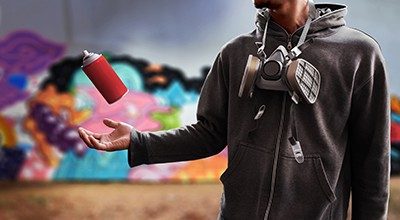FOR IMMEDIATE RELEASE | April 13, 2021
Rescuing street art from vandals’ graffiti
Note to journalists: Please report that this research will be presented at a meeting of the American Chemical Society.
A press conference on this topic will be held Tuesday, April 13, at 11 a.m. Eastern time online.
WASHINGTON, April 13, 2021 — From Los Angeles and the Lower East Side of New York City to Paris and Penang, street art by famous and not-so-famous artists adorns highways, roads and alleys. In addition to creating social statements, works of beauty and tourist attractions, street art sometimes attracts vandals who add their unwanted graffiti, which is hard to remove without destroying the underlying painting. Now, researchers report novel, environmentally friendly techniques that quickly and safely remove over-paintings on street art.
The researchers will present their results today at the spring meeting of the American Chemical Society (ACS). ACS Spring 2021 is being held online April 5-30. Live sessions will be hosted April 5-16, and on-demand and networking content will continue through April 30. The meeting features nearly 9,000 presentations on a wide range of science topics.
“For decades, we have focused on cleaning or restoring classical artworks that used paints designed to last centuries,” says Piero Baglioni, Ph.D., the project’s principal investigator. “In contrast, modern art and street art, as well as the coatings and graffiti applied on top, use materials that were never intended to stand the test of time.”
Research fellow Michele Baglioni, Ph.D., (no relation to Piero Baglioni) and coworkers built on their colleagues’ work and designed a nanostructured fluid, based on nontoxic solvents and surfactants, loaded in highly retentive hydrogels that very slowly release cleaning agents to just the top layer — a few microns in depth. The undesired top layer is removed in seconds to minutes, with no damage or alteration to the original painting.
Street art and overlying graffiti usually contain one or more of three classes of paint binders — acrylic, vinyl or alkyd polymers. Because these paints are similar in composition, removing the top layer frequently damages the underlying layer. Until now, the only way to remove unwanted graffiti was by using chemical cleaners or mechanical action such as scraping or sand blasting. These traditional methods are hard to control and often damaged the original art.
“We have to know exactly what is going on at the surface of the paintings if we want to design cleaners,” explains Michele Baglioni, who is at the University of Florence (Italy). “In some respects, the chemistry is simple — we are using known surfactants, solvents and polymers. The challenge is combining them in the right way to get all the properties we need.”
Michele Baglioni and coworkers used Fourier transform infrared spectroscopy to characterize the binders, fillers and pigments in the three classes of paints. After screening for suitable low-toxicity, “green” solvents and biodegradable surfactants, he used small angle X-ray scattering analyses to study the behavior of four alkyl carbonate solvents and a biodegradable nonionic surfactant in water.
The final step was formulating the nanostructured cleaning combination. The system that worked well also included 2-butanol and a readily biodegradable alkyl glycoside hydrotrope as co-solvents/co-surfactants. Hydrotropes are water-soluble, surface-active compounds used at low levels that allow more concentrated formulations of surfactants to be developed. The system was then loaded into highly retentive hydrogels and tested for its ability to remove overpaintings on laboratory mockups using selected paints in all possible combinations.
After dozens of tests, which helped determine how long the gel should be applied and removed without damaging the underlying painting, he tested the gels on a real piece of street art in Florence, successfully removing graffiti without affecting the original work.
“This is the first systematic study on the selective and controlled removal of modern paints from paints with similar chemical composition,” Michele Baglioni says. The hydrogels can also be used for the removal of top coatings on modern art that were originally intended to preserve the paintings but have turned out to be damaging. The hydrogels will become available commercially from CSGI Solutions for Conservation of Cultural Heritage, a company founded by Piero Baglioni and others. CSGI, the Center for Colloid and Surface Science, is a university consortium mainly funded through programs of the European Union.
The researchers acknowledge support and funding from the European Union NANORESTART (Nanomaterials for the Restoration of Works of Art) Program and CSGI.
To automatically receive press releases from the American Chemical Society, contact newsroom@acs.org.
Note: ACS does not conduct research, but publishes and publicizes peer-reviewed scientific studies.
Media Contact
ACS Newsroom
newsroom@acs.org


